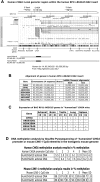Long human CHGA flanking chromosome 14 sequence required for optimal BAC transgenic "rescue" of disease phenotypes in the mouse Chga knockout
- PMID: 20009010
- PMCID: PMC2841496
- DOI: 10.1152/physiolgenomics.00086.2009
Long human CHGA flanking chromosome 14 sequence required for optimal BAC transgenic "rescue" of disease phenotypes in the mouse Chga knockout
Abstract
Chromogranin A (CHGA) plays a catalytic role in formation of catecholamine storage vesicles and also serves as precursor to the peptide fragment catestatin, a catecholamine secretory inhibitor whose expression is diminished in the hypertensive individuals. We previously reported the hypertensive, hyperadrenergic phenotype of Chga-/- knockout (KO) mice and rescue by the human ortholog. In the present study, we compare two humanized CHGA mouse models. Into the Chga null background, by bacterial artificial chromosome transgenesis human CHGA transgene has been introduced. Both lines have the complete approximately 12 kbp CHGA gene integrated stably in the genome but have substantial differences in CHGA expression, as well as consequent sympathochromaffin biochemistry and physiology. A mouse model with longer-insert HumCHGA31 displays integration encompassing not only CHGA but also long human flanking sequences. This is in contrast to mouse model HumCHGA19 with limited flanking human sequence co-integrated. As a consequence, HumCHGA19 mice have normal though diminished pattern of spatial expression of CHGA, and 14-fold lower circulating CHGA, with failure to rescue KO phenotypes to normalcy. In the longer-insert HumCHGA31 mice, catecholamine secretion, exaggerated responses to environmental stress, and hypertension were all alleviated. Promoter regions of the transgenes in both HumCHGA19 and HumCHGA31 display minimal CpG methylation, weighing against differential "position effects" of integration, and thus suggesting that lack of cis elements required for optimal CHGA expression occurs in HumCHGA19 mice. Such "humanized" CHGA mouse models may be useful in probing the physiological consequences of variation in CHGA expression found in humans, with consequences for susceptibility to hypertension and cardiovascular disease.
Figures








Similar articles
-
Cardiac electrical activity in a genomically "humanized" chromogranin a monogenic mouse model with hyperadrenergic hypertension.J Cardiovasc Transl Res. 2014 Jul;7(5):483-493. doi: 10.1007/s12265-014-9563-7. Epub 2014 May 13. J Cardiovasc Transl Res. 2014. PMID: 24821335 Free PMC article.
-
Effects of chromogranin A deficiency and excess in vivo: biphasic blood pressure and catecholamine responses.J Hypertens. 2010 Apr;28(4):817-25. doi: 10.1097/HJH.0b013e328336ed3e. J Hypertens. 2010. PMID: 20139771 Free PMC article.
-
Global metabolic consequences of the chromogranin A-null model of hypertension: transcriptomic detection, pathway identification, and experimental verification.Physiol Genomics. 2010 Feb 4;40(3):195-207. doi: 10.1152/physiolgenomics.00164.2009. Epub 2009 Dec 1. Physiol Genomics. 2010. PMID: 19952279 Free PMC article.
-
Chromogranin A: a novel susceptibility gene for essential hypertension.Cell Mol Life Sci. 2010 Mar;67(6):861-74. doi: 10.1007/s00018-009-0208-y. Epub 2009 Nov 27. Cell Mol Life Sci. 2010. PMID: 19943077 Free PMC article. Review.
-
Chromogranin A: a surprising link between granule biogenesis and hypertension.J Clin Invest. 2005 Jul;115(7):1711-3. doi: 10.1172/JCI25706. J Clin Invest. 2005. PMID: 16007250 Free PMC article. Review.
Cited by
-
Human catestatin peptides differentially regulate infarct size in the ischemic-reperfused rat heart.Regul Pept. 2010 Nov 30;165(1):63-70. doi: 10.1016/j.regpep.2010.07.153. Epub 2010 Jul 22. Regul Pept. 2010. PMID: 20655339 Free PMC article.
-
Molecular Mechanism for Hypertensive Renal Disease: Differential Regulation of Chromogranin A Expression at 3'-Untranslated Region Polymorphism C+87T by MicroRNA-107.J Am Soc Nephrol. 2015 Aug;26(8):1816-25. doi: 10.1681/ASN.2014060537. Epub 2014 Nov 12. J Am Soc Nephrol. 2015. PMID: 25392232 Free PMC article.
-
The mouse genetics toolkit: revealing function and mechanism.Genome Biol. 2011 Jun 24;12(6):224. doi: 10.1186/gb-2011-12-6-224. Genome Biol. 2011. PMID: 21722353 Free PMC article. Review.
-
Adrenergic genetic mechanisms in hypertension and hypertensive kidney disease.Electrolyte Blood Press. 2013 Jun;11(1):24-8. doi: 10.5049/EBP.2013.11.1.24. Epub 2013 Jun 30. Electrolyte Blood Press. 2013. PMID: 23946762 Free PMC article.
-
Mice overexpressing chromogranin A display hypergranulogenic adrenal glands with attenuated ATP levels contributing to the hypertensive phenotype.J Hypertens. 2018 May;36(5):1115-1128. doi: 10.1097/HJH.0000000000001678. J Hypertens. 2018. PMID: 29389743 Free PMC article.
References
-
- Al-Hasani K, Vadolas J, Knaupp AS, Wardan H, Voullaire L, Williamson R, Ioannou PA. A 191-kb genomic fragment containing the human alpha-globin locus can rescue alpha-thalassemic mice. Mamm Genome 16: 847–853, 2005 - PubMed
-
- Chandler J, Hohenstein P, Swing DA, Tessarollo L, Sharan SK. Human BRCA1 gene rescues the embryonic lethality of Brca1 mutant mice. Genesis 29: 72–77, 2001 - PubMed
Publication types
MeSH terms
Substances
Grants and funding
LinkOut - more resources
Full Text Sources
Molecular Biology Databases
Research Materials
Miscellaneous

